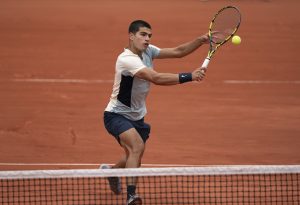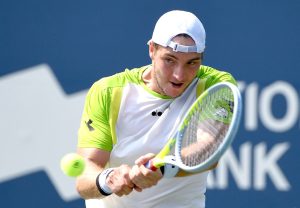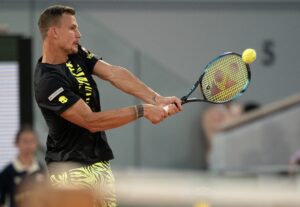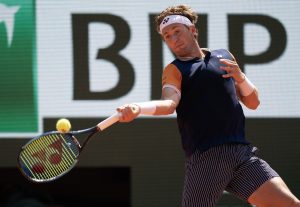The Monte Carlo Masters marks the traditional start of the European clay-court season, at least on the men’s side of the game. Martin Keady looks back at the last week of action from Monaco, to see what lessons can be learned for the rest of the season on ‘le terre battue’.
Five Things We Learned At the Monte Carlo Masters
1. Above All, It’s Great To Have European Clay Court Tennis Back
Because of the Coronavirus pandemic, the 2020 European clay court season was effectively cancelled, with only the French Open surviving, and even that had to be rescheduled for the autumn. It meant that Paris in the Springtime became Paris in the Fall, with some players, such as Victoria Azarenka, resorting to wearing padded jackets on court to try and keep themselves warm.
By contrast, Monte Carlo in 2021 was only lacking fans (still being kept away, of course, for social distancing reasons) from its usual panoply of audio-visual delights. Everything else was present and correct. That includes the most beautiful tennis court in the world, one that directly overlooks the Mediterranean. not to mention the blazing orangey-red of the clay courts themselves, which will always look more beautiful in spring sunshine than autumn drizzle.
Nor should it be overlooked just how enjoyable it was too see the finest male tennis players in the world genuinely extending themselves to win one of the grandest and most historic prizes in the sport outside the Majors. Consequently, the traditional annual tour of continental Europe’s great tennis capitals, which begins in Monte Carlo and culminates at Roland Garros, can be said to have started in style.
2. Both Nadal and Djokovic Are Not Yet At Their Best – But They Soon Might Be
Given that Rafael Nadal has won 11 of the last 16 titles at the ATP Monte Carlo Masters, whilst Novak Djokovic is one of the few other men to have won in Monte Carlo in ‘The Nadal Era’, it was very surprising to see them both falter before the final – indeed, before even the semifinals. Djokovic, of course, lost to Britain’s Dan Evans in the third round, in one of the greatest performances on clay by a Briton in recent memory – at least by a British player whose surname is not Murray.
And Nadal was almost ‘out-Nadaled’ by Andrey Rublev in the quarterfinals, which he also lost in straight sets. As commentator Mark Petchey and doubtless many others were swift to point out, usually a defeat for Nadal and Djokovic is only the prelude to the victory of one of them at the very next Major. That is still the likeliest outcome at Roland Garros, where Nadal will be bidding for tennis immortality by winning his 14th French Open and 21st Major in total, and Djokovic will be his main competition.
Indeed, despite the difficulties that both men experienced in Monte Carlo, it is still a good bet that they will both make the French Open final, given their outstanding pedigree in clay. If they do, the main hope among neutral tennis fans will be that they can finally contest a Major final worthy of the name, after the two most recent men’s Major finals, which were complete blowouts by Nadal at last year’s French Open and Djokovic at the Australian Open in January.
Embed from Getty Images
3. Tsitsipas Is Officially A Master, But Can He Become a Major-winner?
Perhaps it is because Stefanos Tsitsipas looks so much like Bjorn Borg, particularly in the long flowing locks and beard department, that he seems to have been around for so long. However, he can finally be declared a true ‘Master of Tennis’ after his straight-sets demolition of Rublev in Monte Carlo. Given that Rublev, just like Tsitsipas, was going for a debut Masters title, it was particularly disappointing that the final never truly caught light, but on the day the Greek God was, in true tennis parlance, just ‘too good’ for the One-Man Red Army that Rublev usually is on court.
For Rublev, the challenge remains to win a first Masters title, to go with all the other smaller (500 and 250) tournaments that he has already won. For Tsitsipas, it is to translate his newly acquired Mastery into Major success, which is the last step he has to take to achieve tennis greatness. Triumphing in Monte Carlo will only strengthen the suspicion that he has the game to go all the way on clay at Roland Garros.
However, there will be enormous obstacles awaiting him in Paris: not just Nadal and Djokovic themselves, but the five-set format that is now the exclusive preserve of the four biggest tournaments in the sport. It remains hard, if not impossible, to believe that Tsitsipas could win three straight sets against either Nadal or Djokovic, let alone both, so he will be well aware how much more he still has to learn, and prove, on clay. However, given that he has more than a decade in which to do so before he reaches the ages of Nadal or Djokovic, there is every chance that he will eventually catch them up.
Embed from Getty Images
4. Dan Evans Is Definitely The British #1
When he first officially became the top-ranked British male player at the start of 2020, after his heroics at the first ever ATP Cup for Team Britain, Evans insisted with typical self-effacement that Andy Murray was the real British #1 and that he was merely keeping the seat (or umpire’s chair) warm until the great Scot’s return. More than a year on, however, it is increasingly evident that British tennis is already in the post-Murray (or, more precisely, the post-Andy Murray) era and that Evans is unquestionably the British #1.
It is a position that he may hang on to for a while, with Andy Murray still facing an utterly uncertain future after his injury woes and Kyle Edmund announcing at the weekend that he will have to undergo knee surgery that might rule him out for the rest of the season.
If that is the case, then Evans, who is the new world #26 (up seven places after reaching the semifinal), will be a worthy successor to Andy Murray as the face and figurehead of British men’s tennis. It remains unlikely that he will ever win a Masters title, let alone a Major, but having recovered so spectacularly from his drugs ban a few years ago he deserves every success that comes to him.
Embed from Getty Images
5. Sinner and Ruud Are The Men To Watch
In the last two Masters tournaments in Miami and Monte Carlo, Jannik Sinner and Casper Ruud have confirmed that they are perhaps the most likely men to break into the top ten in the coming months, and both will surely have high hopes of eventually challenging for Majors. Sinner reached the final in Miami, where he lost to Hubert Hurkacz, whilst Ruud reached the semifinals in Monte Carlo, where he was beaten in relatively routine fashion by Rublev.
Nevertheless, considering that about 18 months ago both young men were competing at the Next Gen Finals (for the best players under the age of 21) in Turin, they can now be said, for the time being at least, to have outstripped their contemporaries, including Serbia’s Miomir Kecmanovic, France’s Ugo Humbert and the USA’s Frances Tiafoe.
As with Tsitsipas and Rublev, Sinner and Ruud must next step up at the Majors. Of course Sinner has already done so, to a large extent, by reaching the last eight at Roland Garros last October, where for a set he truly challenged Nadal, taking him to a tiebreak, before eventually losing in straight sets. By contrast, Ruud is yet to go beyond the fourth round at a Grand Slam tournament, although his run to the last 16 in Melbourne in January was encouraging.
Tsitsipas’ triumph in Monte Carlo, alongside the real emergence of Sinner and Ruud and the relative frailty on clay shown by both Nadal and Djokovic, makes for a truly compelling clay-court season ahead. Ultimately, of course, it will climax in Paris, for the French Open.
Perhaps that is why Roger Federer has surprisingly announced that he will be re-entering the fray on clay. Perhaps he believes that he himself is the only man he can trust to stop Nadal from overtaking his Majors record. Equally, it is just possible, given that Federer is such a tennis fan (including of tennis history), that he wants to be part of a French Open that could just turn out to be a tournament for the ages.
Main photo:
Embed from Getty Images






